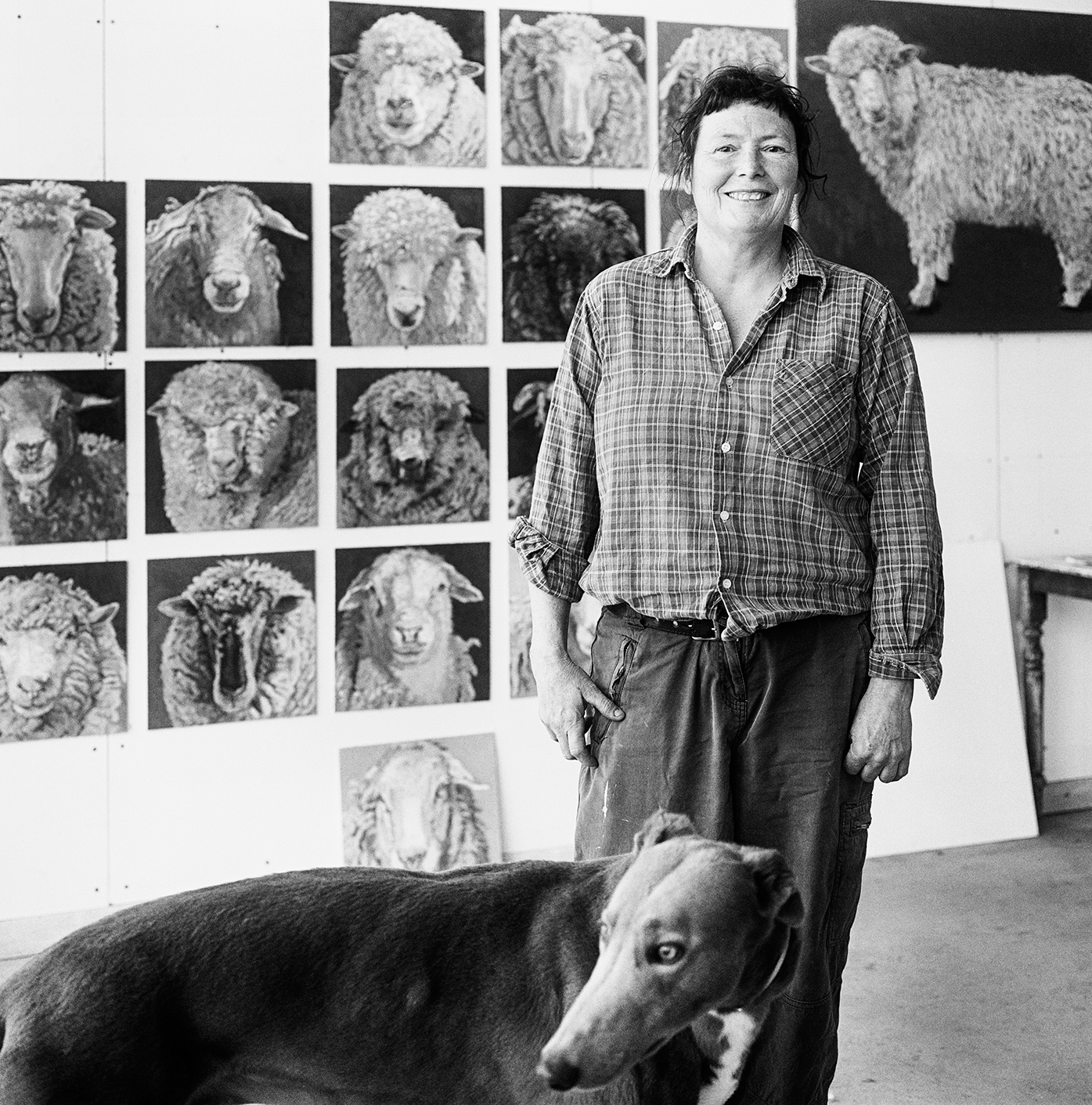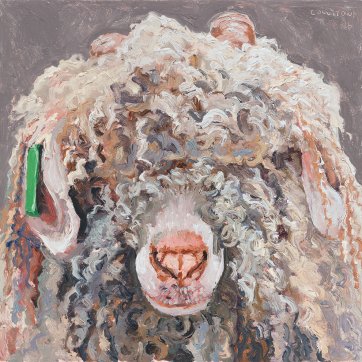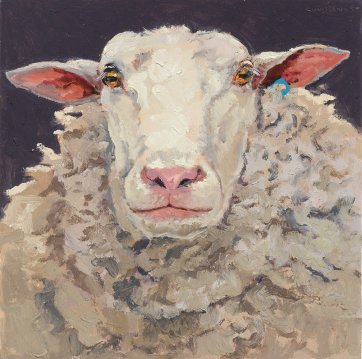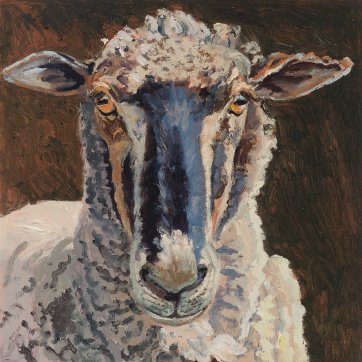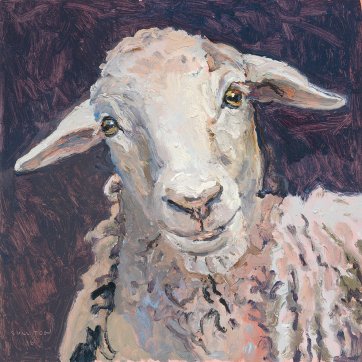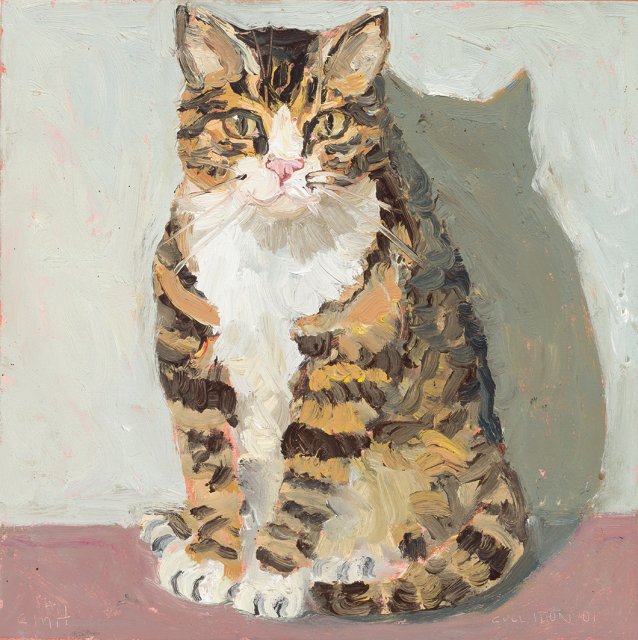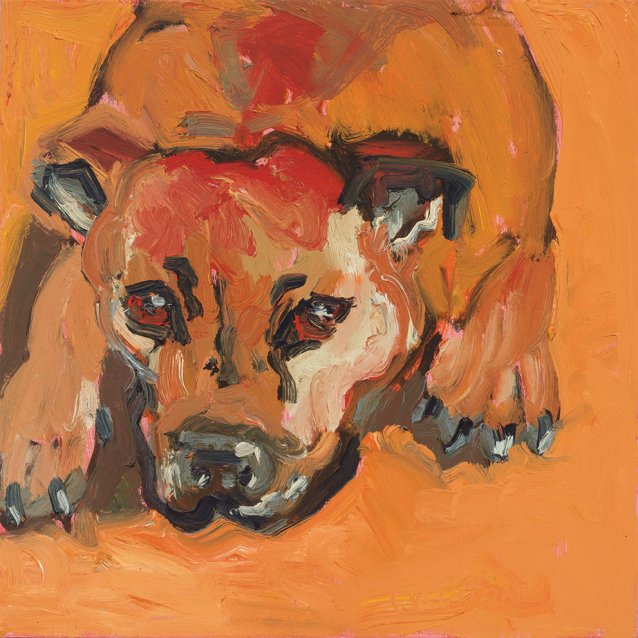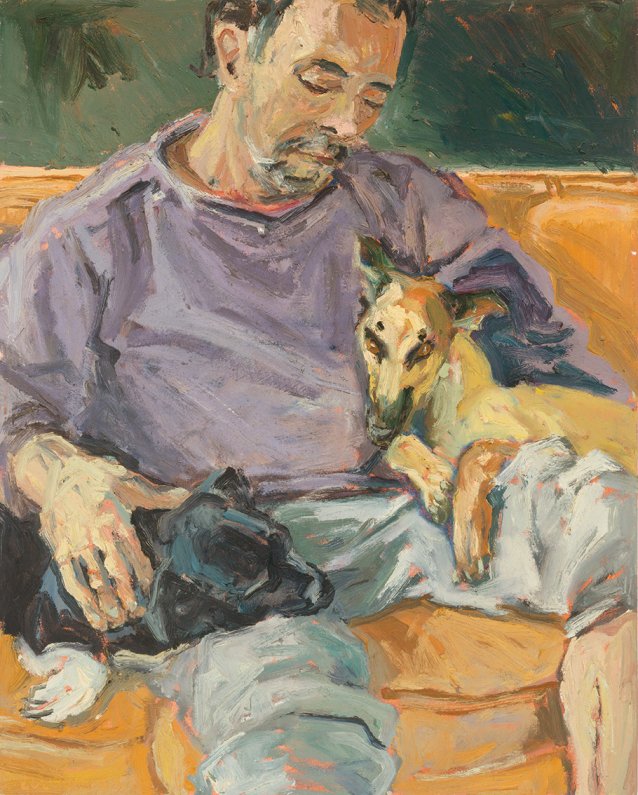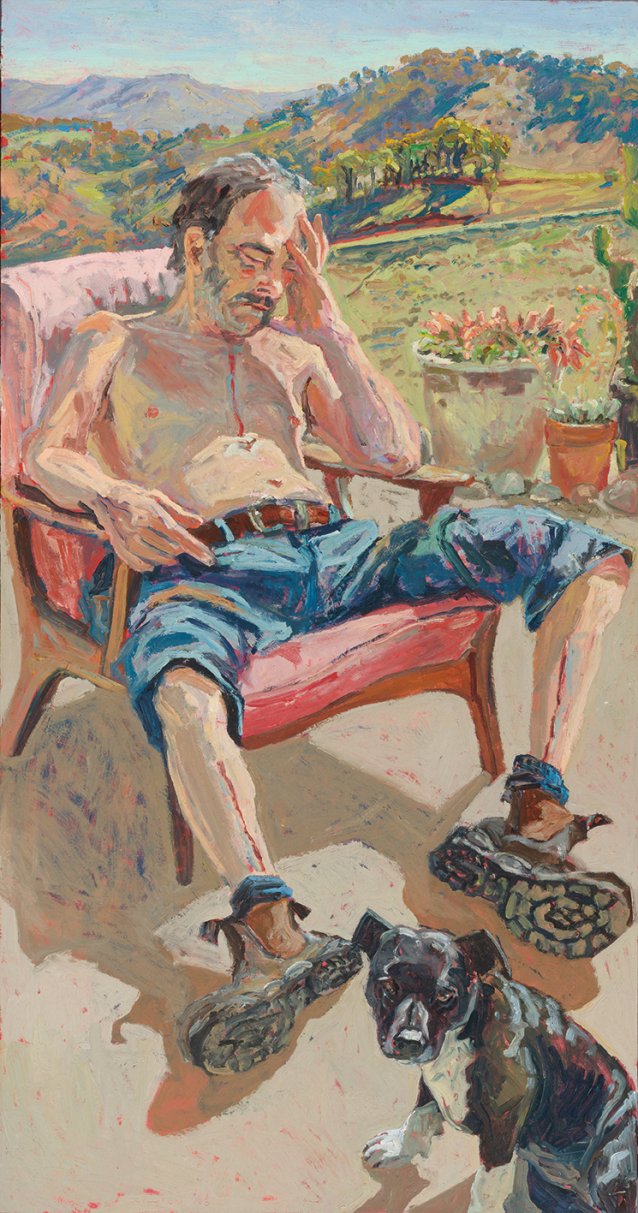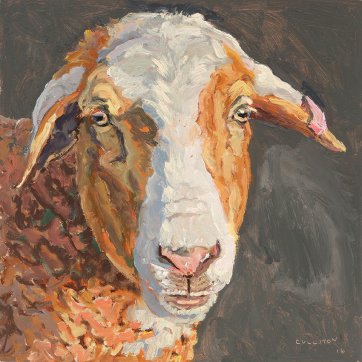A surprising number of artists of very high reputation have painted chickens and other fowls; not just in flocks, as elements of a farmyard scene, but individually, in close-up. In turning her focus on chickens, Lucy Culliton’s not unusual; one critic’s even gone so far as to say that in looking at her pictures of the creatures, ‘one inevitably thinks of Soutine’. However, most well-regarded pictures of chickens, including the twentieth-century Russian-French artist Chaim Soutine’s, show them dead. A reliable way to tell if a chicken in a painting is dead is to check if it’s hanging upside down, because unlike, say, cockatoos, chickens don’t practise inversion for enjoyment in life.
The essential virtue of Lucy Culliton’s idiosyncratic paintings of fowls and other beasts is that they’re alive, full of vigour, and represented as the individual characters she’s found them to be, over months, even years of living in their midst. Lucy’s paintings of chickens - and pigeons - are portraits of her friends. Stepping into her kitchen, you’re likely to see a pigeon on the draining board of her sink, but it’s not defrosting for dinner; raised from birth in the house, it’ll be tramping around on its red legs, twitching its head around, regarding you with interest, you’ll swear, from its shining eyes. Meanwhile, a cockatiel is likely to have fluttered from the table and settled in your hair.
Lucy, a forthright, exuberant and engaging woman, grew up in Sydney, where she went to art school and worked for ten years, miserably, as a graphic designer. After seven years in the Blue Mountains, where she lived very close to her parents and her sister Anna and her family, in 2008 she made a bold move to the edge of the town of Bibbenluke, only slightly nearer to the coast than it is to the snowfields in far south New South Wales. There, in her garden strewn with flowers and fruit trees, stands her old house, in the many rooms of which hang scores of paintings. Along the dim hallway, they fit together closely from floor to ceiling. Around the house there are quite a few ‘china cabinets’, those glass-fronted free-standing cupboards invented to display treasured household items of yore, such as coffee-sets, figurines and sherry glasses. Lucy’s contain not just crockery, but green glass bottles, knitted toys, dolls, snow domes, salt and pepper shakers, prizes from sideshows, shells. They’re not so much arranged behind the glass as crammed in, subverting the whole notion of the display cabinet. There are several dogs, each with a bed in more than one room, and a one-winged, club-footed magpie, Annette, who lives in a cat igloo by the heater. Outside the back door are pots of rampant succulents. Beside the driveway are enclosures for pigeons and other birds; on the way to the studio, a minute’s walk away past a voluble cockatoo, there are sheep, ducks and a massive pig in a commodious pen. Behind a fence are sheep and emus. There’s very little, in or out of china cabinet, flower bed, dog bed, coop, pot or paddock, that hasn’t found its way onto canvas. Lucy Culliton may be the only artist who’s ever made series of paintings of taps, lightglobes, castors, cactus cuttings, padlocks and sparkplugs.
Lucy is one of those painters whose paintings relate closely to each other, as well as to her own history and way of being now. Between life and canvas there’s a constant, evolving exchange. For example, she has pet sheep, and recently she’s painted dozens of head-and-shoulders portraits of them, up close. That’s life; but from a painterly perspective, the sheep portraits developed out of her paintings of inanimate objects: knitted covered coat hangers and woollen dolls’ dresses and babies’ layettes. Having risen to the challenge of representing knitted wool, she went back to the source, painting the different fleeces of her flock, some arranged in greasy swathes, some in corkscrews. In her grave, proud Self-portrait with cow and sheep, apparently painted in a cramped barn, she wears a Western shirt, the kind with shaped, embroidered yokes and slit pockets. She dons such shirts when she goes out on the town; but in the past, too, she’s painted a series of them displayed on knitted hangers. She’s painted many individual portraits of favourite fowls. Her several self-portraits with fowls refer to these paintings, as well as playing, within themselves, on the difference and similarity between hair and feathers, chickens’ and women’s face and neck skin, shrewd human eyes and glinting fowls’ eyes.
Most of us seldom think about how we see our world from different perspectives from second to second, minute to minute; even, say, when we’re looking at someone sitting across the luncheon table, and we keep our eyes on them while we bend to pick up a dropped napkin off the floor. Culliton’s animal subjects are charming, but it’s not only the creatures that draw the attention. The variety of perspectives she employs in her pictures intensifies her viewer’s engagement with them. We see the artist in her Self-portrait with two cocks as she would see herself, looking straight in a mirror with her friends under her arms. Fair enough. Yet the sheep, which we would expect to be painted from above, or the side, at some distance, appear disarmingly as if they, too, are looking directly in a mirror set at their own head height. (Incidentally, note that the unnamed sheep, with tilted head, looks more intelligent than the others; the direct gaze of Steve makes him look more confident and decisive than the others, especially Françoise; and so on. It’s a measure of the cues we use to judge character in humans’ portraits that we see Culliton’s sheep as such individual personalities, for even people who live intimately with sheep rarely see significant differences between their applied knowledge, habits and moods.)
Paintings of horses have a long history – and are often boring – but because of her choice of perspective and composition, Culliton’s tributes to her friends Reno and Phil are very unusual in the equine portrait genre. Typically, artists depict the animals from the side or back-side, to show the length of the legs, the power of the haunches, the arch of the neck and the sway of the back. Culliton’s works, silhouetting the animals’ eyelashes and showing the symmetrical swell of their bellies, are long and thin – the same height as the horses, in fact, which is why the portrait of Reno is a bit taller than the portrait of Phil. Moreover, the beasts, particularly Phil, are very, very close to the picture plane – which means that the viewer feels as if she’s standing right in front of each subject. For someone who keeps a safe distance from horses, as a rule, this is a disconcerting feeling. To cap it all, it’s very unusual for a horse to be painted wearing a blanket. The balaclava effect is alarming; yet the big animal is endearing, too, cosy in his plaid night attire.
When she moved from Surry Hills to Little Hartley, Lucy brought with her eleven pigeons she’d picked up sick from inner-city gutters and footpaths and nursed back to health. Emitt, too, she’d found as a teeny weeny kitten in a garbage bin behind Fatima’s Lebanese restaurant. Her eyes were open and she was so tiny that she hid in the hole of a toilet roll when Lucy brought her home, but she was a spitter and a scratcher. All her life, Emitt only liked Lucy; otherwise, she was a vindictive micturator (Lucy’s sister Anna shudders at her memory). She also had her slim dog Birdy, and when she split up with a city-based boyfriend, his dog, Bonny, decided she preferred a country life and stayed with Lucy in the mountains. When Lucy moved to Bibbenluke, her Dad, Tony, asked her to leave Birdy behind, because the two of them liked having a nap together. Instead, she acquired the eight-week old greyhound Earl, who had great potential as a racing dog except that he was born blind in one eye. The move south required her to drive up and down many times. Earl and Bonny were always in the car; and sometimes pigeons and zebra finches. The horses came separately. They all settled in their new home during a drought; Earl used to scavenge and come home with revolting dead things. The painter looks back with amusement, now, on a time when she had so few pigeons. Some years ago an old pigeon fancier, with hundreds of birds, died in Bega. By that time, Lucy had acquired a reputation as a saviour in the district; the man’s widow told Lucy that she could pick whichever pigeons she liked, and the others would go to Mogo Zoo as a treat for its carnivores. She took them all.
A few years after she moved into Bibbenluke Lodge Lucy had to get the driveway resurfaced, and she put in a call to Jamie’s Bobcats in Bombala; Jamie Morgan-Bruce turned up to do the job. As it happened, according to Lucy, at that time he needed a woman. He’d brought his three-legged dog Bill with him, and the first conversation Lucy and Jamie ever had was about flea remedies. Jamie said he favoured a heavy chemical deterrent and Lucy commented that the smell wouldn’t be very nice in the bed. Jamie asserted that dogs sleep outside. However, from the moment a few months later when Jamie moved in with Lucy, Bill slept by the bed; Jamie didn’t even object when she kept a poddy calf in the house. Lucy knows a couple who have a sheep property and let their sheepdogs sleep on the bed, finding contrary to bush lore that it has no effect on their work ethic.
Just as we look straight on at the horses, in a position to rub their noses as Culliton would, we feel as if we’re looking at the late Emitt sitting on a shelf in one picture –just at the right height to stroke her throat and bib with the back of a forefinger, in the direction of the emphatic, fanned brush strokes. In a second picture, we look down on Emitt in a chair; then again, in a third, we see her as if we’ve come into the room to encounter her asleep on the lap of Louis, who might well be wishing she’d hop off, now. In the portrait of Tony with Molly and Birdy, we feel as if we’re sitting on the floor across from Tony, maybe by a fireplace, sleepily observing the comfortable folds of the man’s loose sloppy joe, registering the warmth of Birdy under his armpit, the pressure of her paws against his inner thigh, the reassurance he gives and gets from laying his right hand on Molly’s shoulders. In another small picture, we’re seeing the late Bonny on the floor at her (our) feet. The painter’s colourful body of work sets down not only the things and entities she sees, but the angles from which she sees them as she moves through house and garden. It’s invigorating.
For a portrait painter, it’s fundamental to imbue the subject with the right physical weight. Floating spells failure. Before there’s any attempt at rendering facial likeness, or personality, a plausible connection has to be established between the person, or animal, and the chair they occupy, or the ground they stand on. It’s delightful to note, then, that little Emitt, draped across the floral chair in a pleasing clash of patterns, is light enough so that her body, mid-way, is pushed upwards by the curve of the old chair seat. There’s none of that in the picture of Culliton’s father Tony, whom she painted recuperating after heart surgery on a sunny concrete porch. He’s dozed off in the bright light, and there’s a palpable feeling of his inert weight in the centre of the armchair. His wounded, enfeebled legs splay, allowing Culliton the pleasure of painting the pattern on the soles of his boots. The portrait of Tony gathers favourite subjects of the artist’s, from the immediate foreground, where Molly sits loosely, her black coat gleaming (the sheen achieved by strokes of diluted white paint applied over her dark body at nose, crown of head, shoulderblades and haunch) to the bare violet-coloured mountain at the top left. On the way to the far view of hills, the eye roves over pots of zygocactus and cactus. The warm verandah serves, in the painting, to provide the open space in the composition.
If you pointed at, say, Lucy’s picture of Birdy asleep on the sofa, and asked a child ‘What’s that?’, she’d probably say, ‘A dog’. But of course, it’s a painting of a dog – a ‘painterly’ one, which draws our attention to the act of representation. In portraying Birdy, Culliton concentrates on the way the light hits her sleek form; different colours, applied in different directions, follow the curves of her lithe body. You would stroke and rub her following the paint – down the length of her throat, around and around on her ribcage, behind her elbow. You’d run your hand down the back of her neckjust as the paint runs. On her haunch, the white paint is applied in the shape of a left bracket, rounding her off, as it were.
More and more, Culliton has come to enjoy the challenge of representing pattern. As she painted the portrait of her friend Chris with her menagerie, she loved depicting the woven cane of the sofa on which Chris sits, and the texture of the cushions arranged along its back. Chris seems to sit with thigh and arm muscles tensed as she tries to keep her frolicsome animals together. We’re conscious that she’s posing, looking directly at the artist. The most unusual aspect of the painting of Chris, however, is her smile. (Chris isn’t the only one smiling in her portrait; the Jack Russell at her right elbow is smiling too.) The toothy smile is rare in a painted portrait. First, there’s the difficulty of representing the complex lines and swellings that appear all over the face when a person smiles. Secondly comes the problem of how to represent teeth; individual incisors, marked out by vertical brown or yellow shadows, can look like tombstone choppers, but a solid sheet of white tends to look as if the subject’s holding a piece of paper behind their lips. Thirdly, even in the cheeriest people, smiles are brief, so all too often the painted smile, prolonged for all time, looks like a crazed grimace. These are amongst the reasons why painters usually go no further than the Mona Lisa smirk, leaving the full-beam smile to photographers. It’s a disconcerting thought that when the lights are all off and all the people have gone home, the painted subject will smile all night into the darkness.
When she entered the Archibald competition in 2016 with a portrait of herself amongst fantail pigeons, Lucy imagined herself spending the prize money on setting up a greyhound rescue facility at home. As she didn’t win, she’s had to limit her intake of hounds; for the time being, she’s showering all her love on the ones she’s already got. The shelves of airport bookshops groan with guides to becoming happy. Lucy - who lives miles from even Cooma aerodrome - is very unlikely ever to have looked at one, and she’ll definitely never write one; but she’s an expert on the topic nonetheless. Years of perseverance at the easel, together with some clear-headed life changes, have set her up for the contentment she gives off now. At Bibbenluke, she can take in all the bedraggled and bereft creatures she wants, and offer them the benison of her care. She can wear the same ragged jumper week-in, week-out; slash off her own hair when it gets in her eyes; dig a new flowerbed at will; hatch a clutch of birds’ eggs in her own kitchen if she pleases. All the while, she can paint day and night. Her determination to create her own happy situation is expressed through her pictures, which radiate her generosity of spirit.
14 portraits view all
1 Blaze, 2016 by Lucy Culliton. 2 Earl sleeping, 2008 by Lucy Culliton. 3 Louis and Emitt, 1998 by Lucy Culliton. 4 Lucy's bathroom, 2010 by Lucy Culliton.
Related people
Related information
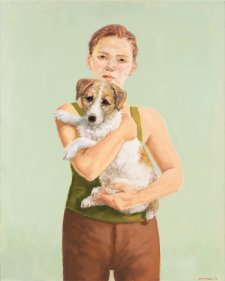
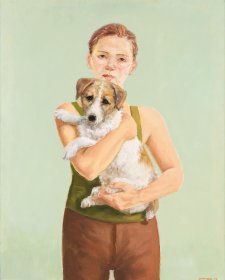

The Popular Pet Show
Previous exhibition, 2016This exhibition expresses the joy and warmth that many of us derive from our animal companions, and celebrates their trusting, unpretentious ways, with portraits of Australians and their furry, feathered and fluffy friends.



The Gallery
Visit us, learn with us, support us or work with us! Here’s a range of information about planning your visit, our history and more!



Support your Portrait Gallery
We depend on your support to keep creating our programs, exhibitions, publications and building the amazing portrait collection!
